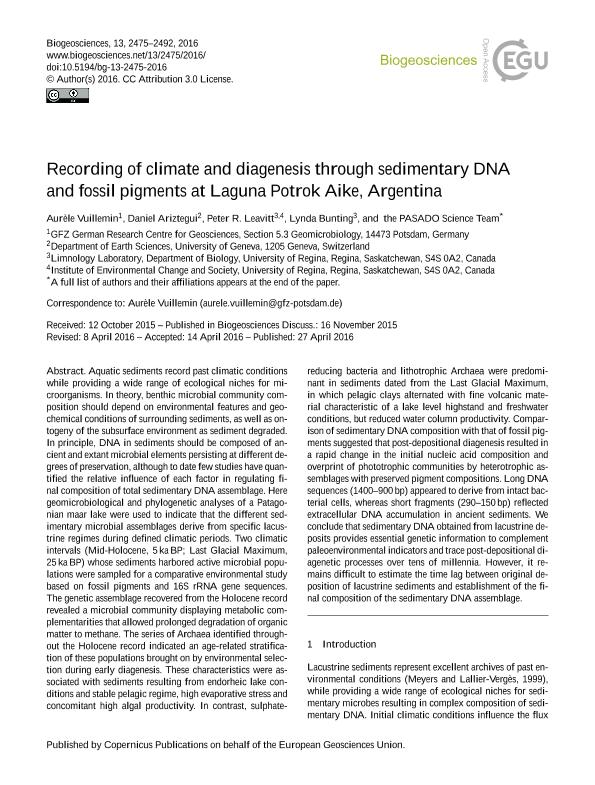Artículo
Recording of climate and diagenesis through sedimentary DNA and fossil pigments at Laguna Potrok Aike, Argentina
Vuillemin, Aurèle; Ariztegui, Daniel; Leavitt, Peter R.; Bunting, Lynda; Anselmetti, Flavio; Ariztegui, Daniel; Corbella, Jorge Hugo ; Francus, Pierre; Lücke, Andreas; Maidana, Nora Irene
; Francus, Pierre; Lücke, Andreas; Maidana, Nora Irene ; Ohlendorf, Christian; Schäbitz, Frank; Wastegård, Stefan; Zolitschka, Bernd
; Ohlendorf, Christian; Schäbitz, Frank; Wastegård, Stefan; Zolitschka, Bernd
 ; Francus, Pierre; Lücke, Andreas; Maidana, Nora Irene
; Francus, Pierre; Lücke, Andreas; Maidana, Nora Irene ; Ohlendorf, Christian; Schäbitz, Frank; Wastegård, Stefan; Zolitschka, Bernd
; Ohlendorf, Christian; Schäbitz, Frank; Wastegård, Stefan; Zolitschka, Bernd
Fecha de publicación:
04/2016
Editorial:
Copernicus Publications
Revista:
Biogeosciences
ISSN:
1726-4189
e-ISSN:
2475-2492
Idioma:
Inglés
Tipo de recurso:
Artículo publicado
Clasificación temática:
Resumen
Aquatic sediments record past climatic conditions while providing a wide range of ecological niches for microorganisms. In theory, benthic microbial community composition should depend on environmental features and geochemical conditions of surrounding sediments, as well as ontogeny of the subsurface environment as sediment degraded. In principle, DNA in sediments should be composed of ancient and extant microbial elements persisting at different degrees of preservation, although to date few studies have quantified the relative influence of each factor in regulating final composition of total sedimentary DNA assemblage. Here geomicrobiological and phylogenetic analyses of a Patagonian maar lake were used to indicate that the different sedimentary microbial assemblages derive from specific lacustrine regimes during defined climatic periods. Two climatic intervals (Mid-Holocene, 5 ka BP; Last Glacial Maximum, 25 ka BP) whose sediments harbored active microbial populations were sampled for a comparative environmental study based on fossil pigments and 16S rRNA gene sequences. The genetic assemblage recovered from the Holocene record revealed a microbial community displaying metabolic complementarities that allowed prolonged degradation of organic matter to methane. The series of Archaea identified throughout the Holocene record indicated an age-related stratification of these populations brought on by environmental selection during early diagenesis. These characteristics were associated with sediments resulting from endorheic lake conditions and stable pelagic regime, high evaporative stress and concomitant high algal productivity. In contrast, sulphate-reducing bacteria and lithotrophic Archaea were predominant in sediments dated from the Last Glacial Maximum, in which pelagic clays alternated with fine volcanic material characteristic of a lake level highstand and freshwater conditions, but reduced water column productivity. Comparison of sedimentary DNA composition with that of fossil pigments suggested that post-depositional diagenesis resulted in a rapid change in the initial nucleic acid composition and overprint of phototrophic communities by heterotrophic assemblages with preserved pigment compositions. Long DNA sequences (1400-900 bp) appeared to derive from intact bacterial cells, whereas short fragments (290-150 bp) reflected extracellular DNA accumulation in ancient sediments. We conclude that sedimentary DNA obtained from lacustrine deposits provides essential genetic information to complement paleoenvironmental indicators and trace post-depositional diagenetic processes over tens of millennia. However, it remains difficult to estimate the time lag between original deposition of lacustrine sediments and establishment of the final composition of the sedimentary DNA assemblage.
Palabras clave:
Dna
,
Microbial Activity
,
Bioproxies
,
Lacustrine Sediments
Archivos asociados
Licencia
Identificadores
Colecciones
Articulos(IBBEA)
Articulos de INSTITUTO DE BIODIVERSIDAD Y BIOLOGIA EXPERIMENTAL Y APLICADA
Articulos de INSTITUTO DE BIODIVERSIDAD Y BIOLOGIA EXPERIMENTAL Y APLICADA
Citación
Vuillemin, Aurèle; Ariztegui, Daniel; Leavitt, Peter R.; Bunting, Lynda; Anselmetti, Flavio; et al.; Recording of climate and diagenesis through sedimentary DNA and fossil pigments at Laguna Potrok Aike, Argentina; Copernicus Publications; Biogeosciences; 13; 8; 4-2016; 2475-2492
Compartir
Altmétricas



